

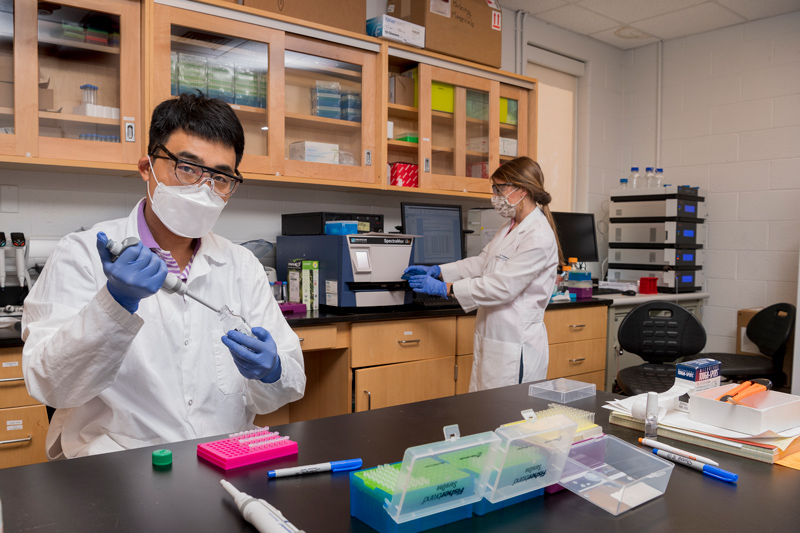
Return to research
Photos by Office of Communications Staff August 17, 2020
Pandemic interruption hit hard for researchers, core facilities, field work
The University of Delaware acted swiftly to ramp down almost all of its research operations to slow the spread of the coronavirus (COVID-19). And it was no small task. UD’s research activity is high — ranked in the top 3% in the United States by the Carnegie Foundation.
The shutdown required far more than turning out the lights and locking the doors of laboratories, offices and other facilities. Some technology requires special handling or consistent attention, all laboratory experiments require careful documentation, valuable data require protections to prevent irretrievable loss and some things simply couldn’t stop.
In two days’ time — from March 15 to March 17 — almost all of UD’s research went from a full gallop to an unprecedented and uncomfortable halt. Only coronavirus-related research and critical functions were permitted to continue.
You can’t just walk away from UD’s Nuclear Magnetic Resonance (NMR) Laboratory, a core facility housed in Brown Laboratory, for example.
“The superconducting magnets require refills of various cryogen liquids routinely without interruptions,” said Steve Bai, director of the NMR Lab, which has six spectrometers used for analysis of organic and inorganic materials, semi-solid materials and biomolecular sampling. “It was of paramount importance to keep these magnets in healthy condition so that they were ready when researchers returned to campus.”
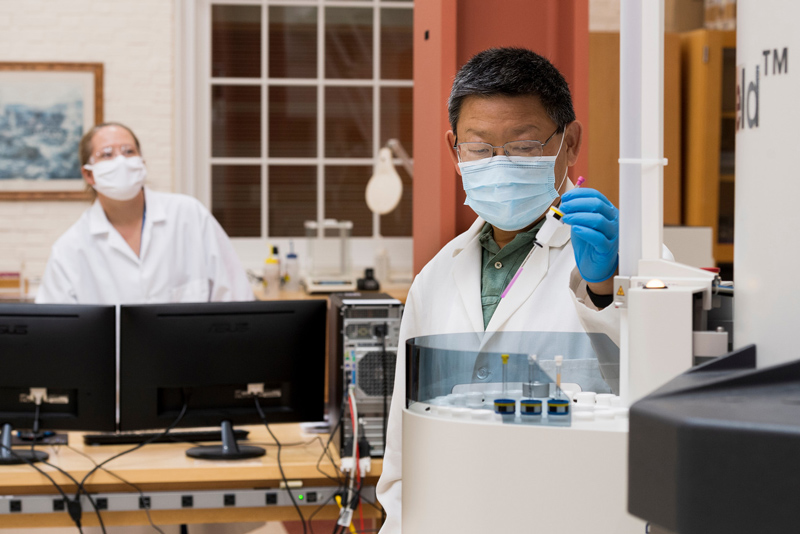
The majority of the enterprise remained shuttered until June 4, when the first wave of eligible investigators started to reopen labs and other facilities. A second wave was approved for return a few weeks later and the third took effect Monday, Aug. 11.
Planning for the mass departure and the phased return has commandeered the schedules of administrators, faculty, staff, students, researchers, facilities managers and health care officials, all of whom convened in scores of virtual meetings to review expert advisories, work out new policies, explain what the changes meant and help everyone stay abreast of changing conditions and guidance from federal and state officials.
Charles G. Riordan, vice president for research, scholarship and innovation, has held weekly online “Research Town Hall” meetings to provide updates and field questions from all concerned. Committees continue to work through hundreds of details, including lab-specific questions and protocols, how to manage grant requirements, guidance for graduate students and other critical needs.
“While surreal doesn’t begin to describe the past five months, it has been incredibly fulfilling to see UD faculty, staff and students come together to care for one another and focus on what truly matters — the health and wellbeing of our community and the continuity of our academic and research missions,” Riordan said. “From efforts to enhance tools to diagnose COVID-19 and 3D print personal protective equipment for front line health care workers to chronicling the crisis’ impact on Delaware, UD scholars have continued to excel.”
As all of this upheaval and restructuring took place, researchers made the most of the time — catching up on writing, data analysis and other mobile-type tasks. They also submitted almost 900 research proposals in the first six months of 2020, an increase of about 6% over the same period in 2019.
UDaily asked several returning researchers about their experiences during this unprecedented interruption and how it affected their work and their perspectives.
Much at stake
The more you learn about research at UD, the more you realize how little you know about the universe and what it takes to develop that knowledge.
From subatomic particles to grand galactic schemes, UD researchers are exploring, testing and questioning just about everything under — and beyond — the Sun. They also are examining cultural questions, government policies, histories, business practices, artistic expression of many kinds and how people, machines and everything around us might work better.
Some of that research is time-sensitive and critical to maintain — perhaps because of the questions being asked, the urgency of world conditions or even a grant deadline. Some research tracks the life cycle of organisms and requires maintenance of sustainable cell lines and regular data collection.
All of it depends on the health and welfare of the researchers and support staff.
The stakes, in other words, are high at every turn. Decisions on what to do, when and how are complicated and demand careful thought.
“Returning to the lab was exciting because I am finally able to progress in my graduate thesis, which is required for me to graduate,” said Mersady Redding, a research assistant in Prof. Jae Kyeom Kim’s Nutrigenomics Lab in the Department of Behavioral Health and Nutrition. “However, I am from rural Arkansas, where COVID-19 has not profoundly impacted my community. Therefore, flying back to Delaware and going back to work was accompanied by some fear that I could catch the virus and end up entirely isolated from my support system.”
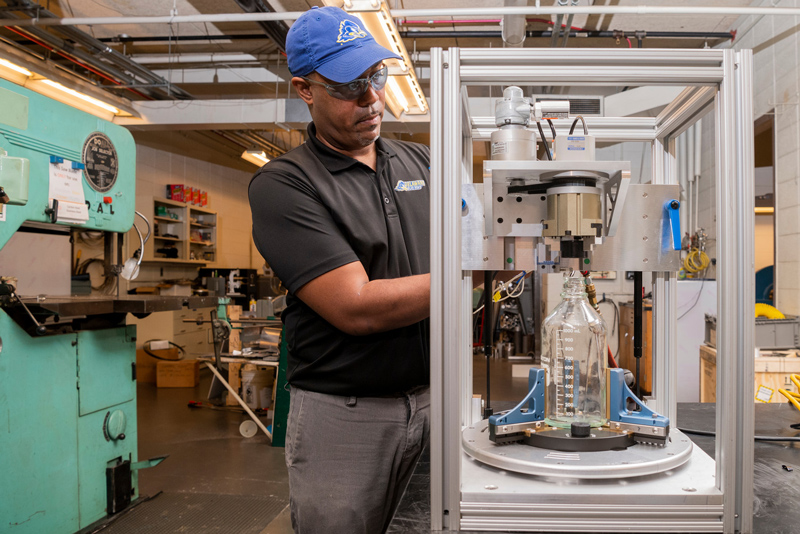
Seeing the new processes and protocols in place in the Department of Physics and Astronomy gave Derrick Allen confidence. Allen, the master machinist in UD’s core machine shop in Sharp Lab, was among those whose work continued throughout the shutdown.
“During Phase 0, I had very limited access, but I was able to observe some of the safety measures that were being put in place,” he said. “So when Phase 1 began, I was very confident that our department had put the proper measures in place to ensure a safe workplace. With that confidence of a safe working environment, I was excited to get back to helping research groups get their projects up and running again.”
Andy Lam, a fifth-year graduate student in the lab of Jessica Tanis, assistant professor of biological sciences, returned to the lab with mixed feelings. He was especially worried about what the hiatus might have done to the rare C. elegans nematodes he has been tending.
“I was excited to be back in the lab because the act of planning and doing experiments is one of my favorite parts of science,” he said. “However, I was also nervous and worried about the condition of the rare strains of C. elegans that I was maintaining before the shutdown. Luckily, both the lab and the C. elegans were in good shape when I came back.”
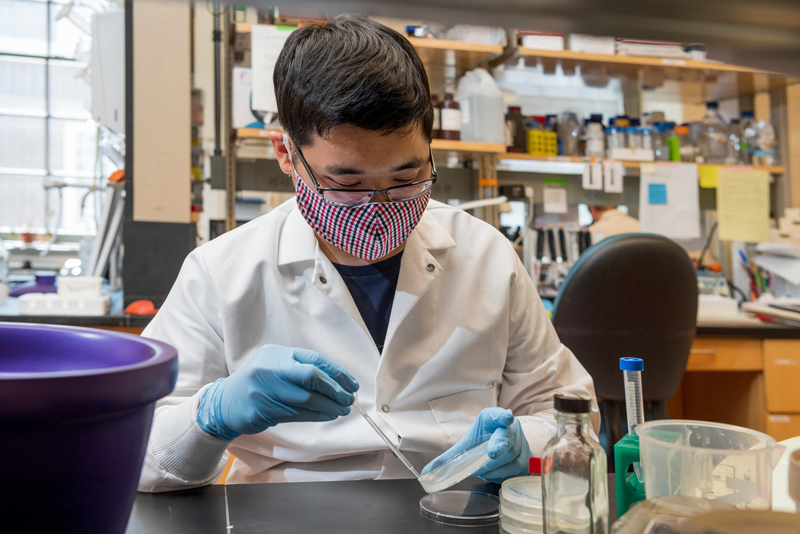
Mission critical
As with any urgent triage where conditions are changing, resources are limited and personnel are restricted, difficult decisions must be made to preserve and protect as much as possible, while minimizing loss.
Instruments must be maintained properly, for example, to avoid irreversible damage. Animals, plants and other living things had to be sustained. And the expertise of skilled colleagues, such as Derrick Allen, was critical to many researchers, too.
“My job is essentially to take raw materials, usually metals and plastics, and use my metalworking skills to turn those materials into functioning parts for new research projects and ideas,” Allen said. “Many of the things I make have never been thought of before or are an attempt to uniquely modify an existing piece of equipment to adapt to suit a new research idea. Often the researcher or grad student only has a vague idea in their head about what they need.”
Allen often designs 3D models of these customized requests to help everyone involved see what the final produce will look like before they invest additional resources in it.
The NMR Lab has about 300 registered users from 38 research groups throughout the University, Bai said, and offers technical support, training and consultation on how this specialized equipment can help investigators solve structure and dynamics problems. More than 100 graduate and undergraduate students have been trained at various levels to use the NMR spectrometers, he said.
Before the shutdown, the NMR Lab averaged 140 samples each day. During Phase 0 of the shutdown, only those doing COVID-19 related research were permitted to use the lab. In the first three weeks of Phase 1, the NMR Lab processed more than 1,000 samples from 45 researchers, he said.
“From this pandemic, we have witnessed the resilience that our students and faculty demonstrated during the ramp-up of the research,” Bai said. “One student after another, one group after another group, the laboratory research efforts have been gradually recovered.”
Losses and delays
Despite extensive planning, all involved knew there would be unavoidable casualties — gaps that could not be made up, changes that could not be observed, experiments that must be abandoned and questions that would be deferred or made even more challenging.
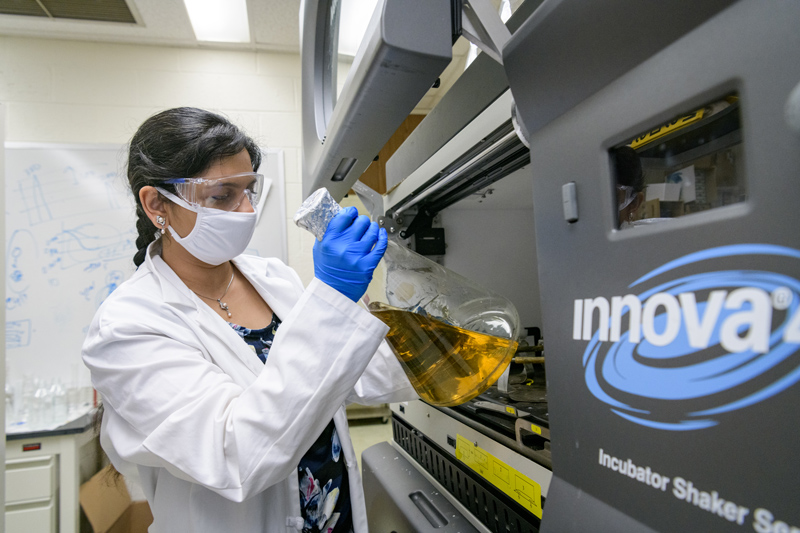
“Research is a never-ending enterprise,” said Mona Batish, assistant professor of medical and molecular sciences in the College of Health Sciences. “Halting life-sciences research completely is actually not practically possible. So we did the best we could do and at the end we still suffered a few losses. For example, some of the cell lines are not growing back and some of our research probes got degraded. While stuck at home, I developed a proposal for COVID-19 related research, but we needed to get back [to campus] to process some data to generate figures for the proposal. We were able to do it just in time and submit the proposal to the National Institutes of Health (NIH). If we had not been approved for Phase 1 reopening, we would have lost the chance to apply for this funding…. The most valuable thing that is lost is time.”
Graduate student Eric Allen of Annandale, Virginia, would agree with that. Allen is studying atmospheric science under the advisement of Prof. Dana Veron in the Department of Geography and Spatial Sciences. In addition to his UD graduate work, Allen is doing an internship — remotely — with the Range and Mission Management Office at the NASA Goddard Space Flight Center’s Wallops Flight Facility.
His work — numerical weather prediction of sea breezes and coastal winds — involves enormous amounts of data and intensive computation. His stay-at-home options had nowhere near that much muscle.
“I was at a point in my work where internet bandwidth caused tasks that should have taken one to two days to take weeks instead,” he said. “I was supposed to finish up my masters at the same time I completed my internship, but this delay may cause me to need another month or so.”
He lost about two months trying to get data safely off UD’s supercomputer and onto a hard drive, a process he says would normally take about a week.
“I completed that process twice to have a backup copy of the data,” he said. “This was fortunate because my primary copy became corrupted. Murphy’s Law. Having that backup saved me time, but it still took about two days to transfer the data over once I got a new hard drive.”
At the machine shop in Sharp Lab, Derrick Allen said several time-sensitive projects were in process when research was shuttered in March.
“Thankfully, some of those critical dates have been moved back by the granting agencies,” he said, “but not every granting agency has been as lenient. I have been contacted by numerous departments who have been granted the ability to reopen, but who need machine shop assistance to complete their research projects.”
Bai said several long-term experiments on sensitive biological molecules had to be halted.
“While this work has resumed, valuable time has been lost and the experiments had to be restarted from the beginning,” he said.
Kim, in the College of Health Sciences’ Nutrigenomics Lab, is exploring how diets affect health and chronic disease and how individuals respond differently to diets.
“We were working on development of a co-culture system in which liver and colon cells are maintained together,” he said. “Due to the shutdown, we had to stop the whole process and thus need to start over.”
Setbacks are not uncommon in research, of course.
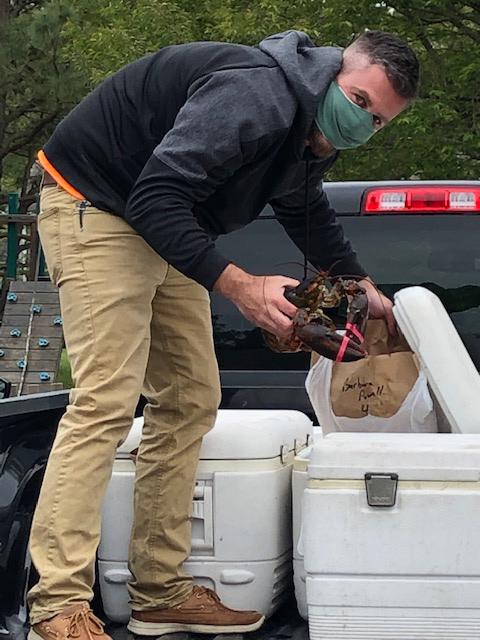
“I have lost days of field work before because of poor and hazardous weather conditions,” said Ed Hale, marine advisory specialist with Delaware Sea Grant, which is housed in UD’s College of Earth, Ocean and Environment. “But I have never had such an unexpected or long-lasting halt to any of my work activities. The coronavirus was incredibly disruptive to life in general. I think many people are still struggling to deal with the reverberations of the shutdown, both in personal (e.g. mental health) and professional matters (e.g. lost income).
Hale works with fishermen, state regulators and citizens to support sustainable fishing and aquaculture economies and promote safe seafood consumption. Most of his research occurs during the spring and summer months, he said.
“I had a lot of field activities planned for the late spring and summer that have been delayed,” he said. “I won’t know if I can catch up on all that I had planned until the fall. At this point, I am just trying to triage and move as quickly and efficiently as possible to accomplish as much as I can.”
Diligent detour
Despite the abrupt ramp-down and detachment from the facilities and advanced resources available to UD researchers, the time was not wasted.
“Certainly, the shutdown was completely unexpected and its damage can hardly be estimated,” Bai said. “However, the research activities outside the laboratory never stopped during the campus shut down. Online scientific workshops, technical training programs and group meetings have been a part of researchers’ daily routines. The crisis has turned into a chance for recharging in knowledge for everyone and it gave us a lifetime opportunity of thinking and planning, which is not always possible during the daily routine.”
Batish said she shifted her focus to developing an R21 proposal (an exploratory and developmental grant) for COVID-19 research.
“In this pursuit, I made new collaborations and gained a lot of insights into virus replication,” she said. “If we are funded, the effort will be worth it and we will feel good to actually do our part to prepare the scientific community to better handle such situations in the future.”
The Nutrigenomics Lab quickly switched to “writing mode,” Kim said.
“We submitted a few manuscripts for publication and received comments to revise, which required additional experiments,” he said. “In this revision process, they allowed us to respond to reviewers’ comments within four weeks. Without the return, I would not be able to revise our manuscripts as requested by the reviewers. In addition, we have a project that does not allow a no cost-extension.”
Students in Jessica Tanis’ lab got a lot of practice developing experimental plans.
“Due to the restrictions, my students cannot work as many hours in the lab as they are used to,” said Tanis, assistant professor of biological sciences. “Yet they are getting the same amount of work done in half the time because they set clearly defined daily, weekly and monthly experimental goals. I think this has shown them that having focused plans increases efficiency and productivity.”
New protocols
Returning to research has required many new practices, as outlined by health officials and UD’s comprehensive plan.
Health screenings — including a brief questionnaire and regular temperature checks — are routine requirements now, along with face coverings, detailed cleaning practices and physical distancing.
Two graduate students in Tanis’ lab said the changes were not a big deal to them.
“It's actually been much easier than expected,” said Mike Clupper. “It's not too hard to fill out a few extra forms and wear a mask. I think the strangest — not necessarily hardest — thing was that only a single person was allowed in the lab at a time during Phase 1 due to the size of the space. Being in the lab by myself could be zen at times, but it was definitely different considering our lab had 10 active members prior to shutdown.”
Andy Lam agreed.
“The University and the Biological Sciences Department were clear about the conditions of the return, so I knew what the expectations were as well as helpful resources. My advisor and I also made a list of experiments and priorities, so I knew what needed to be done when I came back.”
It has been a smooth return, Batish said.
“The new normal of keeping a face mask on and not having in-person meetings is a bit annoying but we are getting used to it,” she said.
New insights
The time of isolation and distance has been enlightening for all who responded to these questions.
“It made us appreciate how little we know about these viruses and how much work is left to be done,” Batish said. “As a scientist, I feel obligated to provide answers to society. When I meet non-science folks, they ask me simple questions like ‘How long will it last? When we will get a vaccine? Why is there no medicine?’
“It really affects me. I feel like society is looking at us for answers and we are not able to provide them. I feel like this should be a wakeup call for policy makers and funding agencies that basic research is very important, and we need to invest in science so that such situations can be avoided for the future.”
Derrick Allen said he has realized afresh that every job has significance to the UD research community.
“It is sometimes easy to fall into the day-in, day-out routine of doing your job, while not realizing the true impact that your work has on the community,” he said. “Once research was shuttered, it became very obvious just how critical everyone is in making the University work. There really are no small jobs here on campus.”
Hale said he learned a lot during the shutdown.
“The experience gave me some time to reflect on all that I had going on in so many different directions personally, which I found helpful,” he said. “Professionally, I thought I would be able to catch up on older analyses and manuscripts that I needed to finish, given that the shutdown did not seasonally coincide with my peak research activity time. Instead, I spent a lot of time on Zoom calls, wondering when they would end. I am still in awe at how drastically and quickly our lives changed in response to a virus. I fear how our country and the world would fare in response to a virus of higher lethality and how our national and global economy will respond. More directly related to UD, I’m curious how this experience will affect campus life, student attendance and interactions. Still, I remain cautiously optimistic at the future and how we will respond to this challenge.”
The experience has been “life changing” for Eric Allen, the graduate student studying atmospheric science.
“I think when I choose a next place to rent or buy, I’ll be considering a work-from-home workspace and flexible leasing agreements,” he said. “Also, I think this is going to lead to more work-from-home opportunities in the future. People can be productive and still connected to the office or classroom in a remote environment.”
He taught a remote Physical Climatology Lab and believes that prepared him for the work he is doing with NASA this summer. He has new insight, too, on the importance of integrated digital platforms for effective communication practices that allow teams to provide updates, ask questions and share documents.
Redding said being detached from the lab has shaped her approach to challenges.
“Things do not always go as planned,” she said. “I have learned to be adaptable and prioritize the necessary when the ideal is not feasible…. Research is an ongoing, constantly changing realm. I had not previously thought about what the consequences would be if suddenly all research was halted. COVID-19 shined light on not only how many people are dedicated to progressing scientific knowledge, but also how many lives have been improved or saved because of this knowledge. It is a critical time for research to continue, and I think many great minds have used these past few months to ask new questions and brainstorm new ideas. I believe we will see huge advances in knowledge as researchers return to work.
Words to the wise
In the midst of such fundamental change, master machinist Derrick Allen urges his colleagues to be patient and diligent as they return to work.
“We are all learning, simultaneously, how to live in this new COVID world,” he said. “With that said, a little patience with each other goes a long way. If something looks out of place or needs attending to, once the appropriate personnel are notified, it will be addressed. But a little patience can very often calm everyone’s frustrations.
“As for diligence, although it can seem tiresome, repetitive and meaningless, please remember that your small acts are saving lives. Face masks, social distancing, handwashing, etc. have been scientifically proven to work. I believe, specifically as a research community, it is our responsibility to do those behaviors which have already be proven to be affective to help to mitigate the spread of this virus.”
Contact Us
Have a UDaily story idea?
Contact us at ocm@udel.edu
Members of the press
Contact us at 302-831-NEWS or visit the Media Relations website

